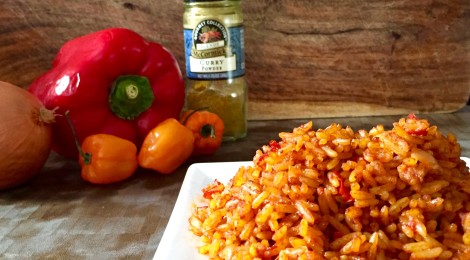
Jay’s Nigerian Jollof Rice
When the first blizzard of 2016 hit New York City last weekend, there was little to do in Harlem but stay inside, relax in front of the fireplace, and watch it snow, and snow, and snow. Unfortunately, our 2.5 year old Liam fell sick, so keeping him comfortable and occupied all day was our main goal. Once he was nestled in bed for the night, Sean and I needed to figure out our dinner. Suddenly, there was a knock at the door. Our lovely neighbor Jay said, “I made a huge dinner, would you like to have some?” and handed us containers of Nigerian stewed chicken and Jollof Rice. Neither of us had ever tried Nigerian cuisine, and honestly, as exhausted parents, we couldn’t believe someone was handing us a home cooked dinner. We were really touched by her thoughtfulness.

The view from our Harlem window just as Blizzard Jonas was making its debut in New York City on Saturday morning.
We cracked open the containers. At first glance, the Jollof Rice looked like a simple tomato rice dish. How deceiving. It was so much more than that. With flavors that tasted like they had been carefully stoked for hours, smoky grains of perfectly cooked rice were richly coated by tomato, red pepper, and onion and sharpened by scotch bonnet peppers that made our eyes water…in the best way possible! Sean started eating it right out of the container and couldn’t stop, saying “This rice is incredible!”
Jay explained it’s a family recipe for a classic Nigerian dish called Jollof Rice that she had learned from her sister, who in turn, had learned it from their grandmother. When she said it included a generous amount of curry powder, I just knew I had to share it with you — what could be more fitting for a blog called Big Apple Curry that focuses on Indian-inspired home cooking in New York City? The way that most people feel about making Indian food is how I feel about making African food — I wouldn’t know where to begin. I’ve had neither the exposure nor opportunity to try much African cuisine, never mind homemade African food, until Jay knocked on our door.

“The Curry Trail’ map shows the influence of Indian spices around the world on many cuisines, including Africa (Source: Madhur Jaffrey “Curries and Kebabs” cookbook)
I know that like India, Africa’s geographic size is considerable and is home to many different cuisines based on local ingredients and indigenous crops. Indian spices and herbs influenced many cuisines around the world through colonization, the spice trade, and migration patterns for centuries. During the British Empire in the 19th century, many Indians were sent to Africa as indentured servants to develop plantations, and lived under conditions similar to slavery. According to Indian culinary expert Madhur Jaffrey, as thousands of Indians worked in South Africa, the local cuisine gave way to “…mild curries and pilafs and curry-flavored kebabs…ships would be packed with rice, dal, ghee, mustard and coconut oil, preserved meat, dried fish, flour, and a few seasonings — cumin, fenugreek, fresh ginger, tamarind, and salt.” In fact, Jaffrey says, “the spread of Indian flavors…went all over Africa and its surrounded islands, and aspects of Indian food are to be found in most countries. I have had Nigerian stews flavored with both ground peanuts and curry powder, a mouth-watering combination.”

Jollof Rice is a classic dish from West Africa, although its origins are debated (Photo Source: Wikipedia)
Jollof Rice in particular is considered a West African dish that likely originated in Nigeria, but its history is hotly contested. According to Wikipedia, Jollof Rice is “West Africa’s version of pilaf or paella, and possibly a progenitor of the Louisianian dish jambalaya…the dish consists of rice, tomatoes and tomato paste, onions, salt, spices (such as nutmeg, ginger, Scotch bonnet (pepper), and cumin) and chili peppers; optional ingredients can be added such as vegetables, meats, or fish. Due to the tomato paste and palm oil, the dish is always red in color.”
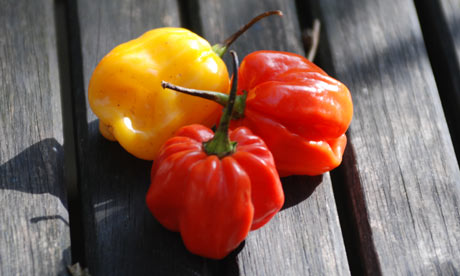
While scotch bonnet (habanero) peppers are not native to Africa, they are native to the Caribbean so easily found in North American supermarkets. For this reason, they are often used as the requisite “chilli peppers” in Jollof Rice recipes. (Photo source: The Guardian)
You must be tempted to make this dish now! The best part about Jay’s family recipe is the ingredients are easily found in most supermarkets — parboiled rice, curry powder, tomato paste, bullion cubes, red bell pepper, onion, and habanero peppers (scotch bonnet peppers). If you’re vegetarian or vegan you can use vegetable bullion or stock; if you’re serving it to little ones or folks who don’t like too much heat, you can skip the habanero peppers completely. If you have curry powder in your cupboard and rarely use it, this is a great way to put it to work. If you go for the Scotch bonnet peppers, be sure to pair it with a cool yogurt raita. What better way to warm up in a blizzard?
Jay’s Nigerian Jollof Rice
Serves 4-6
Ingredients
- 2 cups uncooked parboiled white rice (any type of rice will do, but I particularly like the firm texture and individual grains of cooked parboiled rice)
- 1 red bell pepper
- 1 to 2 Scotch bonnet (habanero) peppers
- 1 medium-sized onion
- 2 tablespoons tomato paste
- 3 tablespoons canola oil
- Either 2 bullion cubes + 4 cups of water OR 2 cups of stock + 1 cup of water
- 2 tablespoons curry powder
- Salt to taste
Preparation
- Preheat your oven to 400F degrees.
- Clean and remove the stems of the red bell pepper and scotch bonnet peppers.
- Clean and peel the onion
- Place the peppers and onion into a food processor with the water and coarsely chop them (if you don’t have a food processor, you can coarsely chop the ingredients by hand).
- In a medium-sized oven-safe saucepan, add canola oil and heat on a medium-high flame. Add a teaspoon of the coarse onion-pepper mixture; once it starts sizzling and moving a bit, add the rest and begin to “sweat” the mixture, which means it will sizzle and become glassy and golden.
- After 5 minutes, add the tomato paste, curry powder, and bullion cubes, mixing well to combine.
- Add the parboiled rice and mix well until each grain of rice is fully coated by the mixture.
- Using a wooden spoon, gently flatten the rice mixture along the bottom of the saucepan and allow the rice to brown slightly, this enables the rice to absorb the mixture — the rice should make a slight crackling noise as this happens.
- Turn the heat down to low, allowing the rice to brown for about 10 minutes, stirring every couple of minutes to make sure it doesn’t burn – this process is the key to giving the rice its smoky flavor.
- If you used bullion cubes, now add 4 cups of water; if you did not use bullion cubes, add at least 2 cups of stock and one cup of water.
- Increase the heat to medium and cover the pot with a tightly matching lit. Set the timer to 15 minutes.
- After 15 minutes, turn off the flame and stir the rice.
- Cover the pot and place it into the preheated oven on the middle rack.
- Bake for 30 minutes after which remove the pot from the oven and stir the rice. Leave it to cool uncovered for 5-10 minutes before serving.
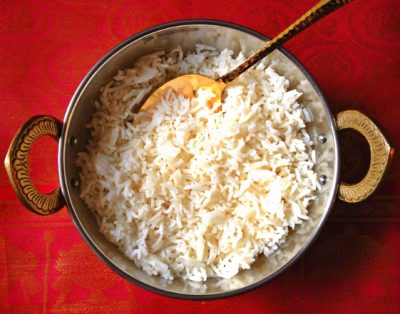

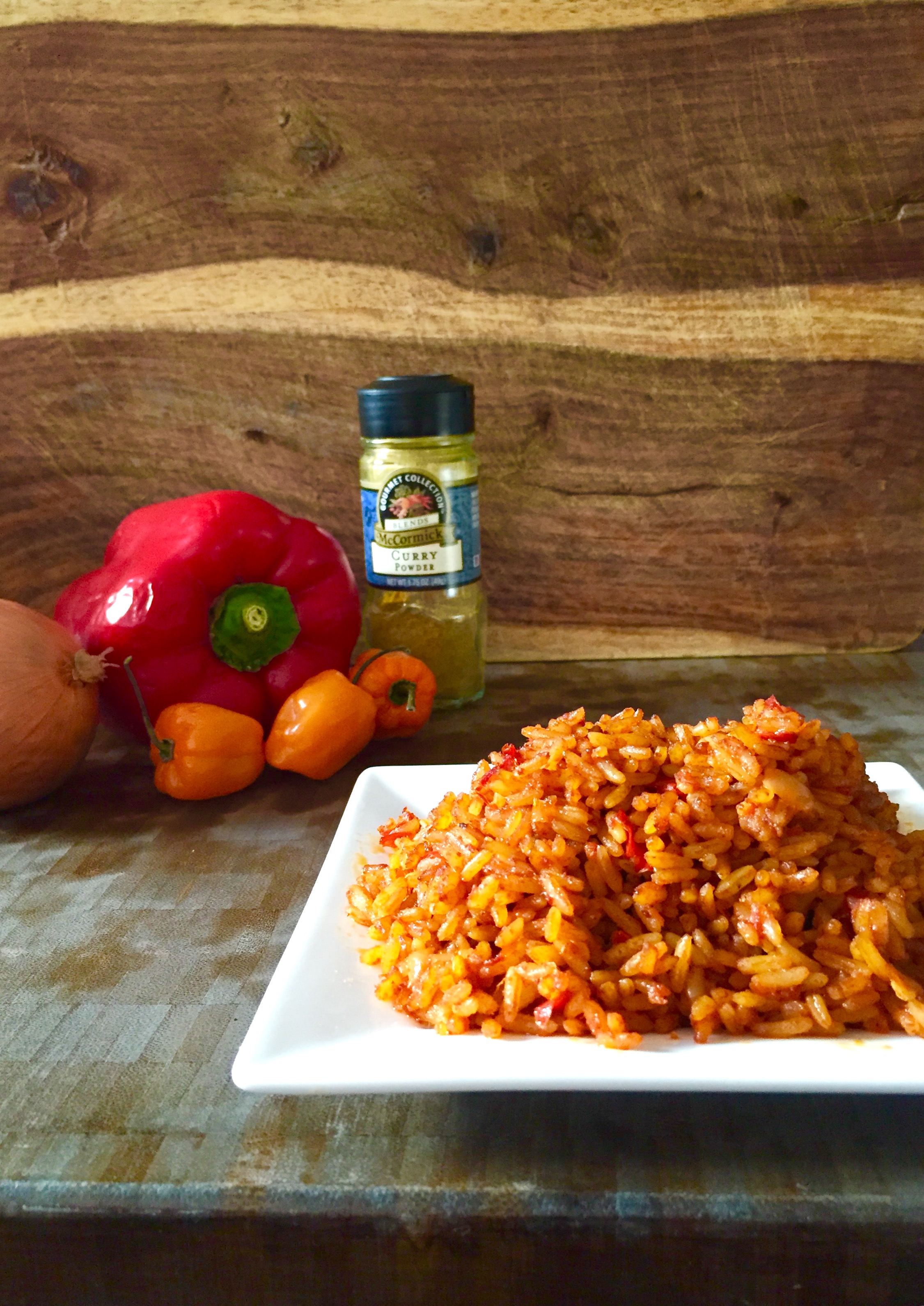

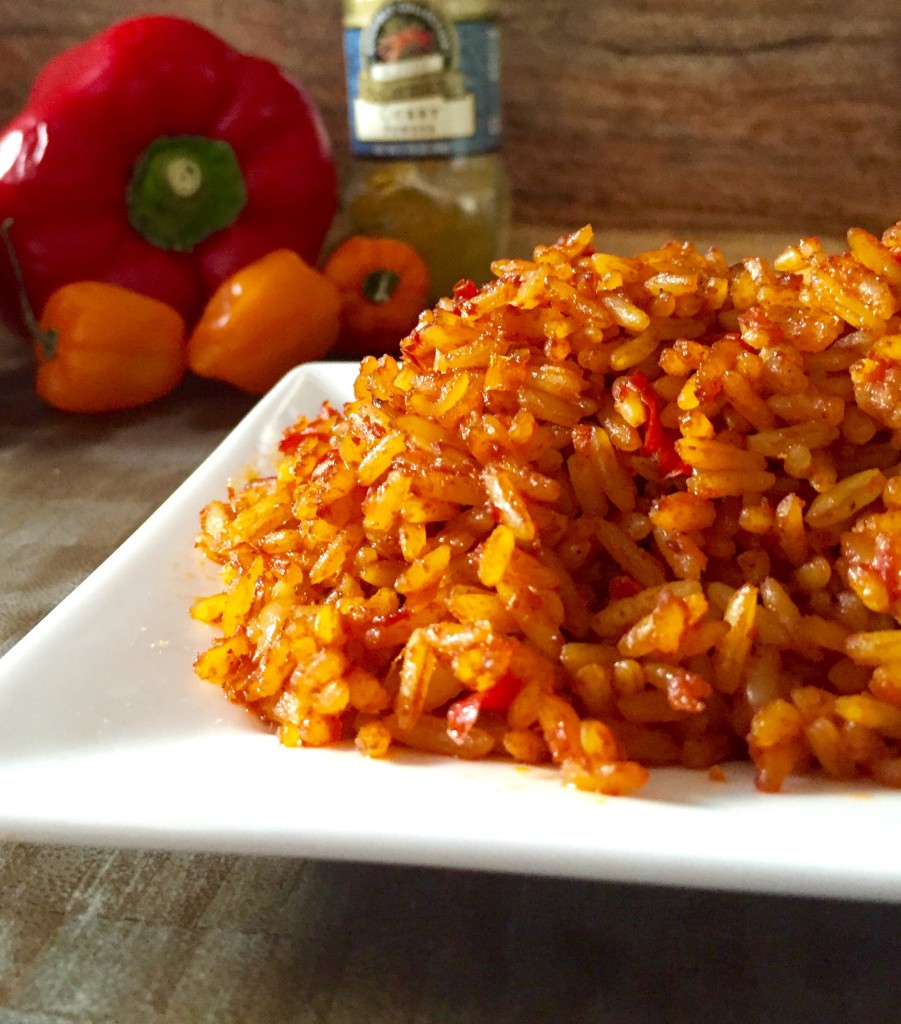
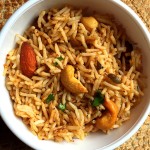
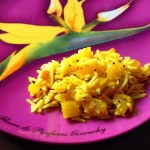
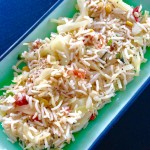

Hello Lancenia!
Thanks for visiting us! Yes, this rice can be made on the stovetop but our friend Jay doesn’t recommend it because it won’t have the same smoked taste. If you do make it on the stovetop, the cooking time will depend on the type of rice you use (most rice bags will let you know their standard stovetop cooking time on the bag). Please let me know if you make this!
With best wishes for the New Year,
Ina
Hi can this rice be made on the stove as well.